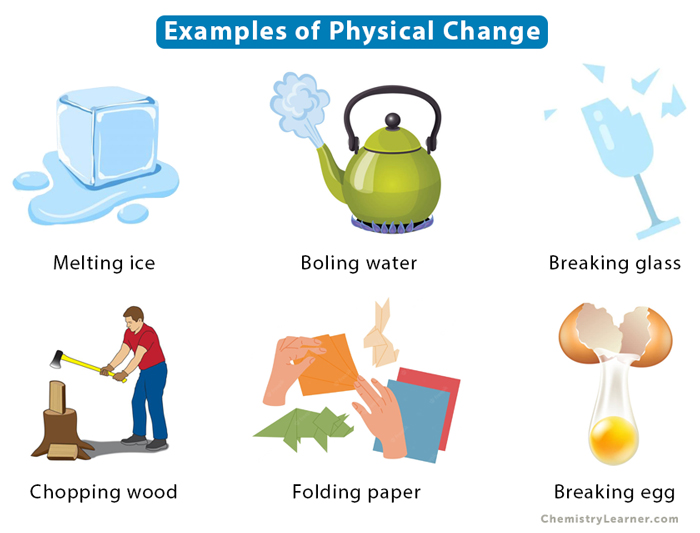Physical Change
A physical change involves a change in the size, shape, and sometimes color of matter. In a physical change, the substance does not change its chemical composition. No bonds are broken and formed. No new substances are created. The composition of the matter remains the same before and after the change. Some properties of matter may change, but the overall identity remains the same [1-4].
Types and Examples of Physical Change [1-4]
1. Change of State
Change of state refers to melting, boiling, freezing, and condensation. Ice melts into water and changes its shape. During this process, the chemical formula of ice, H2O, remains unchanged. Hence, the melting of ice is an example of endothermic physical change, which is represented by the following equation:
H2O (s) + heat ⇌ H2O (l)
When water is heated, it boils. The composition of water does not change. It still has two molecules of hydrogen and one molecule of oxygen. Only liquid water is converted into gaseous vapor. The following reaction represents it:
H2O (l) + heat ⇌ H2O (g)
Physical changes involving a change of state are all reversible. When ice melts into water, we can get the ice back by freezing water. When water boils into vapor, we can get water back by condensing the vapor. Condensation and freezing are exothermic processes and are represented by the following reactions:
H2O (g) ⇌ H2O (l) + heat
H2O (l) ⇌ H2O (s) + heat
2. Change of Texture
The change in texture is defined by the change in the appearance of the material’s surface. When a piece of rough wood is sanded, waxed, and polished, it will look very different from before.
3. Change of Color
Changing the color of a substance is a physical change as long as there is no chemical reaction involved. For example, when you paint the surface of a car, the paint does not chemically react with the surface.
4. Change in Temperature
Although the temperature change is not visible to the eyes, it is considered a physical change. For example, consider a cooking pan sitting idle in a cupboard. It does not undergo any change. We do not physically see any change until we heat the pan. When we touch the hot pan, we can feel the heat. Therefore, the temperature of the pan changes. Everything else remains unchanged.
5. Change in Shape
Change in shape is an indication of physical change. When we wash, dry, and iron clothes, we fold them before putting them back in the wardrobe. We are only changing the shape of our clothes.
Other Examples of Physical Change
- Mixing sand and water
- Breaking a glass
- Chopping wood
- Shredding paper
- Sublimation of salt
- Squeezing a balloon
- Making orange juice
FAQs
Ans. As the temperature increases, the molecules rush. As a result, the attraction between the molecules breaks down, and the substance rapidly transforms from one phase to another.
Ans. Mass and the number of molecules are conserved during physical changes.






Thank you for telling me the answer